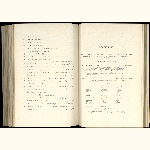Details of exhibit
- Exhibition:
- 1913 Fifty-eighth Annual Exhibition of the Royal Photographic Society of Great Britain
- Exhibit title:
- Original negatives of spectra of metals
- Exhibitor:
- Lt.-Col. J. W. Gifford
- Section:
- III. Scientific and Technical Exhibits, Natural History, Colour Prints, Lantern and Stereoscopic Slides
- Exhibit No.:
- 551
552 - Description:
- Faint lines are made more prominent, weak one less so by the application of starved development.
List of Spectra
No. 1.
Magnesium.
Zinc.
Cadmium.
Lead.
Thallium.
Copper.
Silver.
No. 2.
Cadmium.
Aluminium.
Manganese.
Iron.
Cobalt.
Nickel.
Chromium.
No . 3.
Gold.
Platinum.
Palladium.
Ruthenium.
Rubidium.
Iridium.
Osmium.
No. 4.
Tin.
Cadmium.
Zinc.
Titanium.
Vanadium.
Bismuth.
Antimony.
No. 5.
Cadmium.
Iron.
Chromium.
Molybdenum.
Tungsten.
Uranium.
Tellurium.
No. 6.
Cadmium.
Indium.
Arsenic.
Iridium.
Iron.
No. 7.
The elimination of air lines by an inductance.
Iron without inductance. Aluminium with. Iridium with.
Iron with inductance. Aluminium without. Iridium without.
Note by the Author
Ultra-violet Spectra of some of the Metals.
The accompanying photographs of the ultra-violet spark spectra were taken on the large spectrometer with quartz train constructed to my order some years since by Messrs. Hilger, Ltd.
This instrument has objectives of 3 in. aperture, and a large quartz prism of 60° (consisting of two half prisms of 30° of right and left quartz, respectively), giving an effective aperture of 2¾ ins.
The focal length of the objectives in use for wave-length 2748 (Cd.) is 27½ ins., nearly. I have taken this wave-length for the centre of the field in all the photographs. The width of slit used was about 0.001 in.
A large aplanatic quartz condenser of 3 in. aperture and focus, together with the spark apparatus, slides on parallel bars attached to the collimator and serves the slit.
The spark is produced by an Apps 18 in. spark coil working in conjunction with four two-gallon Leyden jars. The time of exposure was in almost every case half a minute, no attempt having been made to eliminate air lines. The effects of such an attempt are shown on a separate film, and inductance having been introduced into the secondary circuit of the coil as suggested by Hemsalech. Under these circumstances it is necessary to double the exposure. But air lines only again become prominent with a fuller exposure, and I think that an exposure of a quarter minute without the inductance and using "starved" development will bring about practically the same result.
The films used were in close contact with the curved template, the whole being tilted to make an angle of about 64.5° with the axis. These films were "process" films, prepared for me by Messrs. Wratten & Wainwright, and were graded for sensitivity by the number 43 (Watkins). They have served my purpose admirably.
The spark spectrum of uranium is especially noteworthy. At first sight apparently continuous, it resolves itself under a low-power lamp into a series of exceedingly close fine lines. It is suggested that such a spectrum should be useful as a basis for registering absorption in the ultra-violet. - Exhibit type:
- Photograph
- Process:
- [Not Listed] ()
- Award:
- none

